Indian shot, Queensland arrowroot
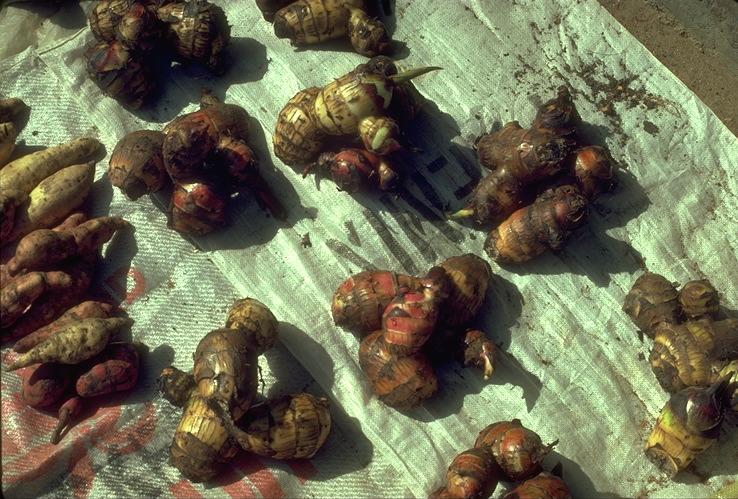
A tropical plant. It is grown and used in some of the coastal areas of the tropics and subtropics. It will grow from sea level up to 1600 m. In the Andes it grows between 1,000 and 2,500 m altitude. It needs a heavy fertile soil. It cannot stand strong winds. It does best with an evenly distributed rainfall. It cannot stand waterlogging. It grows in wetlands. It can stand some shade. It needs to be in a frost free location. It does best where both days and nights are warm. It grows in hardiness zones 8-12. In Sichuan and Yunnan.
Also known as:
Achera, Achira, Acira, Adalut, Ambaradeda, Araruta bastarda, Ar-do, Australian arrowroot, Balisier, Balisier, Berg, Biru manso, Biru manso, Bungah tasbih, Caite, Capacho, Chisgua, Cucurds, Dingiza, Dinioka, Dong rieng, Essbare canna, Fanamanu, Ganyong, Gasau, Gontha, Gruya, Imbirg, Kalvazhai, Kana, Kattaye, Kuentas-kuentasan, Mei ren jiao, Meru, Pann-u, Pipirigallo, Pisang sebiak, Platanillo, Purple arrowroot, Saka siri canna, Sakhu chin, Sembu, Sugu, Te riti, Tous-les-mois, Zembu
Synonyms
- Canna achiras Gillies
- Canna bidentata Bertol.
- Canna cinnabarina Bouché
- Canna coccinea Mill.
- Canna compacta Roscoe
- Canna edulis Ker Gawl.
- Canna esculenta Lodd. ex Loudon
- Canna humilis Bouché
- Canna indica L. var. limbata (Roscoe) Petersen
- Canna lanuginosa Roscoe
- Canna limbata Roscoe
- Canna lutea Mill.
- Canna lutea Mill. var. aurantiaca (Roscoe) Regel
- Canna lutea Mill. var. genuina Kraenzl.
- Canna nepalensis Wall.
- Canna orientalis Roscoe
- Canna rubricaulis Link
- Canna speciosa Roscoe
- Canna variabilis Willd.
- Canna warszewiczii A.Dietrich
Edible Portion
- Fruit, Root, Rhizome, Tubers, Vegetable, Flowers
Where does Indian shot grow?
Found in: Africa, American Samoa, Andes, Antilles, Argentina, Asia, Australia, Bahamas, Belize, Bolivia, Brazil, Cambodia, Cameroon, Central Africa, Central America, Chile, China, Colombia, Congo DR, Costa Rica, Côte d'Ivoire, Cuba, Dominican Republic, East Africa, East Timor, Ecuador, El Salvador, Eswatini, Europe, Fiji, France, Gabon, Germany, Ghana, Grenada, Guam, Guatemala, Guiana, Guyana, Haiti, Honduras, India, Indochina, Indonesia, Iraq, Ivory Coast, Jamaica, Kiribati, Kurdistan, Laos, Madagascar, Malawi, Malaysia, Marquesas, Mexico, Myanmar, Nauru, Nicaragua, Niger, Nigeria, North America, Northeastern India, Pacific, Pakistan, Panama, Papua New Guinea, PNG, Paraguay, Peru, Philippines, Rotuma, Samoa, Sao Tome and Principe, SE Asia, Senegal, Sierra Leone, Slovenia, South Africa, Southern Africa, South America, Sri Lanka, St Helena, Suriname, Swaziland, Taiwan, Thailand, Timor-Leste, Tonga, Trinidad, Turkey, Tuvalu, Uganda, Uruguay, United States, Vanuatu, Venezuela, Vietnam, West Africa, West Indies
Notes: There are about 10 Canna species. They grow in the tropics and subtropics. They originally came from tropical America.
Status: It is a commercially cultivated vegetable. It is a starchy root crop of some importance in some coastal areas mainly on the Papuan side of Papua New Guinea.
Growing Indian shot, Queensland arrowroot
Cultivation: They can be grown from seed. It is more easy to grow them by dividing the plant. The crowns should not be planted too deeply. The end section of the rhizome is planted. Well developed tubers with one or two undamaged buds should be used. A spacing of 1 m x 1 m is suitable. Tubers are planted about 15 cm deep and need to be kept weed free during early growth. About 2.5 tons of tubers are required to plant a hectare. The tubers are dug from between 6 and 19 months. The tubers can be stored if cool and dry. For starch manufacture they need to be processed immediately.
Edible Uses: The rhizomes are a source of starch. The rhizomes are eaten after cooking. They are boiled or baked. The leaves and rhizomes are used for animals. Starch can be extracted from the roots. This is achieved by rasping the tubers, then washing the starch out and straining out the fibres. The large starch grains are very digestible. The starch is used to make transparent noodles. The young shoots can be eaten as a green vegetable. Immature seeds are cooked.
Production: Harvesting occurs after about 8 months. Parts of the underground root are harvested as needed. High yields of tops and rhizomes are possible. Up to 38 tons of rhizomes and 50 tons of tops have been achieved.
Nutrition Info
per 100g edible portion| Edible Part | Energy (kcal) | Protein (g) | Iron (mg) | Vitamin A (ug) | Vitamin c (mg) | Zinc (mg) | % Water |
|---|---|---|---|---|---|---|---|
| Fruit | - | - | - | - | - | - | |
| Root | 34 | 1.7 | - | - | 5.6 | - | 88.8 |
Indian shot, Queensland arrowroot Photos

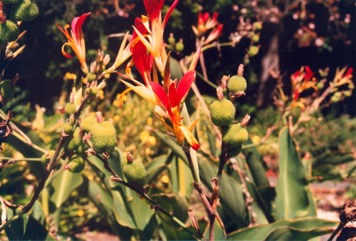
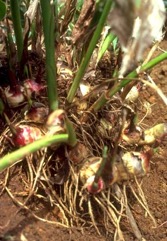
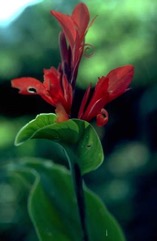
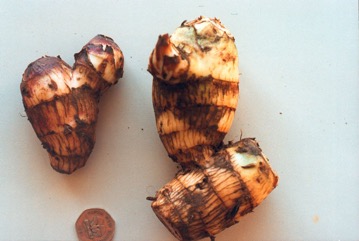
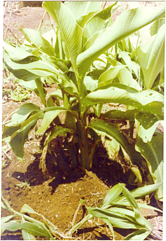
References
Queensland arrowroot references (Canna indica syn. C. edulis)
ALCORN, (As Canna lutea)
Altschul, S.V.R., 1973, Drugs and Foods from Little-known Plants. Notes in Harvard University Herbaria. Harvard Univ. Press. Massachusetts. no. 461
Ambasta S.P. (Ed.), 2000, The Useful Plants of India. CSIR India. p 101 (Also as Canna edulis)
Arinathan, V., et al, 2007, Wild edibles used by Palliyars of the western Ghats, Tamil Nadu. Indian Journal of Traditional Knowledge. 6(1) pp 163-168
Aryal, K., Moe, A.T., Hein, P.P., Bay, Y.H.S., Htay, T., Aung, H.W., Shakya, B., Xuefei, Y., Shaoliang, Y. ,2020, Wild and non- cultivated edible plants and their contribution to local livelihoods in Putao, Myanmar. ICIMOD.
Bernholt, H. et al, 2009, Plant species richness and diversity in urban and peri-urban gardens of Niamey, Niger. Agroforestry Systems 77:159-179
Bodkin, F., 1991, Encyclopedia Botanica. Cornstalk publishing, p 210
Borrell, O.W., 1989, An Annotated Checklist of the Flora of Kairiru Island, New Guinea. Marcellin College, Victoria Australia. p 18 (As Canna edulis)
Bot. Reg. 9: t. 775. 1823 (As Canna edulis)
Brickell, C. (Ed.), 1999, The Royal Horticultural Society A-Z Encyclopedia of Garden Plants. Convent Garden Books. p 225
Brouk, B., 1975, Plants Consumed by Man. Academic Press, London. p 227 (As Canna edulis)
Burkill, H. M., 1985, The useful plants of west tropical Africa, Vol. 1. Kew.
Burkill, I.H., 1966, A Dictionary of the Economic Products of the Malay Peninsula. Ministry of Agriculture and Cooperatives, Kuala Lumpur, Malaysia. Vol 1 (A-H) p 440 (As Canna edulis), p 441 (As Canna orientalis)
Castillo, R. O., 1995, Plant Genetic Resources in the Andes: Impact, Conservation, and Management. Crop Science 35:355-360
Cundall, P., (ed.), 2004, Gardening Australia: flora: the gardener's bible. ABC Books. p 324
de Polle, E., Plantas Silvestres Comestible de Guatemala. 1(1) Universidad de San Carlos de Guatemala. (As Canna edulis)
Diaz-Betancourt, M., et al, 1999, Weeds as a future source for human consumption. Rev. Biol. Trop. 47(3):329-338
Dividich, J., Le, 1977, Feeding Value of Canna edulis Roots for Pigs. J. Ag. univ. Puerto Rico. (56): 3 p 267- (As Canna edulis)
Engel, D.H., & Phummai, S., 2000, A Field Guide to Tropical Plants of Asia. Timber Press. p 125
Facciola, S., 1998, Cornucopia 2: a Source Book of Edible Plants. Kampong Publications, p 71 (As Canna coccinea), (Also as Canna edulis)
Franklin, J., Keppel, G., & Whistler, W., 2008, The vegetation and flora of Lakeba, Nayau and Aiwa Islands, Central Lau Group, Fiji. Micronesica 40(1/2): 169–225, 2008
French, B.R., 1986, Food Plants of Papua New Guinea, A Compendium. Asia Pacific Science Foundation p 20 (As Canna edulis)
French, B.R., 2010, Food Plants of Solomon Islands. A Compendium. Food Plants International Inc. p 35 (As Canna edulis)
Flora of Australia Volume 49, Oceanic Islands 1, Australian Government Publishing Service, Canberra. (1994) p 501
Gade, D.W., 1966, Achira, the edible canna, its cultivation and use in the Peruvian Andes. Econ. Bot. 20(4), 407-415. (As Canna edulis)
Gard. dict. ed. 8: Canna no. 4. 1768 (As Canna lutea)
Goode, P., 1989, Edible Plants of Uganda. FAO p 26 (As Canna edulis) Hedrick, U.P., 1919, (Ed.), Sturtevant's edible plants of the world. p 149, p 132 (As Canna achiras, Canna coccinea and Canna edulis)
Hermandez Bermejo, J.E., and Leon, J. (Eds.), 1994, Neglected Crops. 1492 from a different perspective. FAO Plant Production and Protection Series No 26. FAO, Rome. p18 (As Canna edulis)
Heywood, V.H., Brummitt, R.K., Culham, A., and Seberg, O., 2007, Flowering Plant Families of the World. Royal Botanical Gardens, Kew. p 356 (As Canna achiras)
Hibbert, M., 2002, The Aussie Plant Finder 2002, Florilegium. p 59
Hu, Shiu-ying, 2005, Food Plants of China. The Chinese University Press. p 329 (As Canna edulis)
IRVINE, (As Canna bidentata)
Jardin, C., 1970, List of Foods Used In Africa, FAO Nutrition Information Document Series No 2.p 12 (Also as Canna bidentata)
Joyal, E., 1987, Ethnobotanical Field Notes from Ecuador: Camp, Prieto, Jorgensen, and Giler. Economic Botany 41(2): 163-189 (As Canna edulis)
Kay, D.E., 1973, Root Crops. T.P.I. Crop & Product Digest No 2, London, p 120 (As Canna edulis)
Kays, S. J., and Dias, J. C. S., 1995, Common Names of Commercially Cultivated Vegetables of the World in 15 languages. Economic Botany, Vol. 49, No. 2, pp. 115-152
Keller J. 2001, 2005, Canna, based on Mansfeld's Encyclopedia of Agricultural and Horticultural Crops' (P. Hanelt & IPK (eds.) 2001, Springer [Version 6.18] at IPK Gatersleben 2002. < http://mansfeld.ipk-gatersleben.de/Mansfeld/taxonomy/search_names-mf.htm >.
Kinupp, V. F., 2007, Plantas alimenticias nao-convencionais da regiao metropolitana de Porto Alegre, RS, Brazil p 72
Kiple, K.F. & Ornelas, K.C., (eds), 2000, The Cambridge World History of Food. CUP p 1713 (As Canna edulis)
Larios, et al., 2013, Plant management and biodiversity conservation in Náhuatl homegardens of the Tehuacán Valley, Mexico. Journal of Ethnobiology and Ethnomedicine 2013 9:74.
Lazarides, M. & Hince, B., 1993, Handbook of Economic Plants of Australia, CSIRO. p 46 (Also as Canna edulis)
Lembaga Biologi Nasional, 1977, Ubi-Ubian, Balai Pustaka, Jakarta. p 30 (As Canna edulis)
Leon, J., 1968, Fundamentos Botanicos de Los Cultivos Tropicales p (As Canna edulis)
Lim, T. K., 2015, Edible Medicinal and Non Medicinal Plants. Volume 9, Modified Stems, Roots, Bulbs. Springer p 22
Liu, Yi-tao, & Long, Chun-Lin, 2002, Studies on Edible Flowers Consumed by Ethnic Groups in Yunnan. Acta Botanica Yunnanica. 24(1):41-56 (As Canna edulis)
Low, T., 1991, Wild Herbs of Australia and New Zealand. Angus & Robertson. p 103 (Drawing) (Also as Canna edulis)
Llamas, K.A., 2003, Tropical Flowering Plants. Timber Press. p 168
Maas-van de Kramer, H., & Maas P. J. M., 2008, The Cannaceae of the World. Blumea 53:247-318
Macmillan, H.F. (Revised Barlow, H.S., et al) 1991, Tropical Planting and Gardening. Sixth edition. Malayan Nature Society. Kuala Lumpur. p 337 (As Canna edulis)
McClatchey, W., Thaman, R., & Vodonaivalu, S., 2000, A Preliminary Checklist of the Flora of Rotuma with Rotuman Names. Pacific Science (2000) Vol. 54, No. 4: 345-363
Medhi, P. & Borthakur, S. K., 2012, Phytoresources from North Cachur Hills of Assam -3: Edible plants sold at Hflong market. Indian Journal of Natural Products and Resources. 3(1) pp 84-109
Miguel, E., et al, 1989, A checklist of the cultivated plants of Cuba. Kulturpflanze 37. 1989, 211-357 (As Canna edulis)
Morley, B.D., & Toelken, H.R., (Eds), 1983, Flowering Plants in Australia. Rigby. p 353, 354 (As Canna edulis)
Morton, J.K., 1961, West African Lilies and Orchids. Longmans. p 52
Ochse, J.J., Dijkman, M.J.,Soule, M.J.& Wehlburg, C.,1961, Tropical and Subtropical Agriculture. p (As Canna edulis)
Ochse, J.J. et al, 1931, Vegetables of the Dutch East Indies. Asher reprint. p 93 (As Canna edulis)
Peekel, P.G., 1984, (Translation E.E.Henty), Flora of the Bismarck Archipelago for Naturalists, Division of Botany, Lae, PNG. p 111, 110
Peters, C. R., O'Brien, E. M., and Drummond, R.B., 1992, Edible Wild plants of Sub-saharan Africa. Kew. p 14 (As Canna indica)
Plants for a Future database, The Field, Penpol, Lostwithiel, Cornwall, PL22 0NG, UK. http://www.scs.leeds.ac.uk/pfaf/ (Also as Canna edulis)
Plants of Haiti Smithsonian Institute http://botany.si.edu
Polini, G., et al, Useful and edible plants of Paraguay Region of Chaco. p 52
PROSEA (Plant Resources of South East Asia) handbook, Volume 9, 1996, Non seed starch.
Purseglove, J.W., 1972, Tropical Crops. Monocotyledons. Longmans p 92 (Also as Canna edulis)
Recher, P, 2001, Fruit Spirit Botanical Gardens Plant Index. www.nrg.com.au/~recher/ seedlist.html p 1 (As Canna edulis)
Romanowski, N., 2007, Edible Water Gardens. Hyland House. p 83 (As Canna edulis), (Also as Canna lanuginosa)
Sarvalingam, A., et al, 2014, Wild edible plant resources used by the Irulas of the Maruthamalai Hills, Southern Western Ghats, Coimbatore, Tamil Nadu. Indian Journal of Natural Products and Resources 5(2):198-201
Scarpa, G. F., 2009, Wild food plants used by the indigenous peoples of South American Gran Chaco: A general synopsis and intercultural comparison. Journal of Applied Botany and Food Quality 83:90-101
Seidemann J., 2005, World Spice Plants. Economic Usage, Botany, Taxonomy. Springer. p 78
Smith, A.C., 1979, Flora Vitiensis Nova, Lawaii, Kuai, Hawaii, Volume 1 p 216
Smith, N., Mori, S.A., et al, 2004, Flowering Plants of the Neotropics. Princeton. p 424 (Drawing), Plate 56 (Photo) p 425 (Also as Canna edulis)
Smith, P.M., 1979, Queensland arrowroot, in Simmonds, N.W., (ed), Crop Plant Evolution. Longmans. London. p 304 (As Canna edulis)
Sp. pl. 1:1. 1753
Staples, G.W. and Herbst, D.R., 2005, A tropical Garden Flora. Bishop Museum Press, Honolulu, Hawaii. p 645 (Drawing), p 646 (Also as Canna edulis)
Stone, B. C., 1970, The Flora of Guam. A Manual for the Identification of the Vascular Plants of the Island. Micronesica. Journal of the University of Guam. p 112 (As Canna edulis)
Sukarya, D. G., (Ed.) 2013, 3,500 Plant Species of the Botanic Gardens of Indonesia. LIPI p 1087 (Also as Canna lutea)
Swaziland's Flora Database http://www.sntc.org.sz/flora
Tanaka,T., 1976, Tanaka's Cyclopedia of Edible Plants of the World. Keigaku Publishing, Tokyo. (As Canna edulis)
Tapia, M. E., The role of under-utilised plant species with regard to increased food security and improved health of poor poeople, in mountain regions. IIAP-PNUD/Peru (As Canna edulis)
Terashima, H., et al, 1992, Ethnobotany of the Lega in the Tropical Rainforest of Eastern Zaire (Congo): Part Two, Zone de Walikale, African Study Monographs, Suppl. 19:1-60
Terra, G.J.A., 1973, Tropical Vegetables. Communication 54e Royal Tropical Institute, Amsterdam, p 35 (Also as Canna edulis)
Thaman, R. R, 2016, The flora of Tuvalu. Atoll Research Bulletin No. 611. Smithsonian Institute p 43
UPHOF, (As Canna bidentata)
Uprety, Y., et al, 2016, Traditional use and management of NTFPs in Kangchenjunga Landscape: implications for conservation and livelihoods. Journal of Ethnobiology and Ethnomedicine (2016) 12:19
Valder, P., 1999, The Garden Plants of China. Florilegium. p 354
van Wyk, B., 2005, Food Plants of the World. An illustrated guide. Timber press. p 114 (As Canna edulis)
Wealth of India, 1959, Council of Scientific and Industrial Research, New Delhi. p 58 (As Canna edulis)
Williams, C.N., Chew, W.Y., and Rajaratnam, J.A., 1989, Tree and Field Crops of the Wetter Regions of the Tropics. Longman, p 217. (As Canna edulis)
Williamson, J., 2005, Useful Plants of Malawi. 3rd. Edition. Mdadzi Book Trust. p 52 (As Canna bidentata)
Woodward, P., 2000, Asian Herbs and Vegetables. Hyland House. p 48
World Checklist of Useful Plant Species 2020. Royal Botanic Gardens, Kew
Wu Delin; W. John Kress, CANNACEAE, Flora of China
Yuncker, T.G., 1959, Plants of Tonga, Bernice P. Bishop Museum, Hawaii, Bulletin 220. p 86
Zhang, Y., et al, 2014, Diversity of wetland plants used traditionally in China: a literature review. Journal of Ethnobiology and Ethnomedicine. 10:72